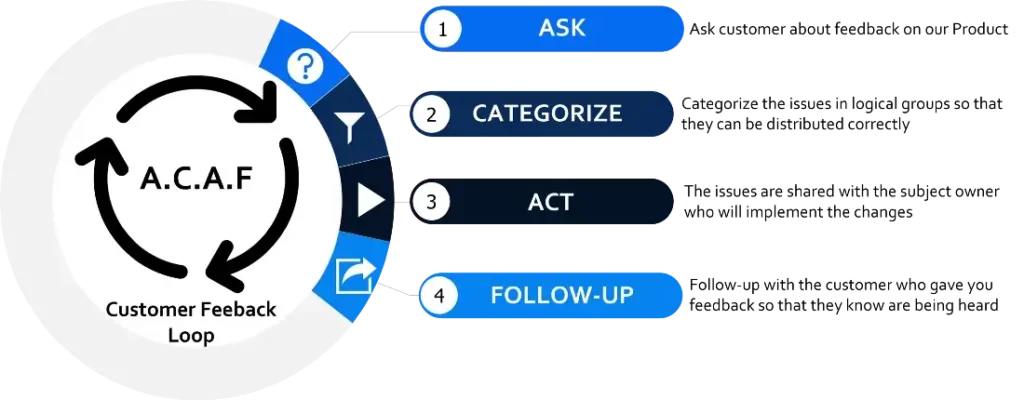
Your customer is always telling you what they want, all you need to do is listen.
In today’s fast-paced and competitive market, businesses are constantly vying for customer attention and loyalty. To stand out and meet the ever-increasing expectations of consumers, it is vital for businesses to understand what their customers truly want.
One effective way to do this is by utilizing customer feedback, which is the comments, suggestions, or evaluations provided by customers about a product, service or company.
By paying close attention to customer feedback, businesses can gain valuable insights into their customers’ needs and preferences, allowing them to make informed decisions about their offerings and ultimately improve the overall customer experience.
ACAF Framework: Holy Grail of Feedback management.
One competent method for feedback management is the ACAF Framework, which stands for Ask, Categorize, Act, and Follow-Up.
- The Ask step involves monitoring social media, review sites, and other online platforms for mentions of the company or its products/services. This includes setting up alerts and notifications for specific keywords, hashtags, and mentions of the company’s name.
- The Categorize step involves categorizing responses based on their nature, including identifying the type of response (positive, neutral, negative), the source of the response (customer, competitor, influencer, etc.), and the urgency of the response.
- The Act step involves taking action based on the identified and categorized responses. This could include responding to positive comments, addressing negative comments, or escalating urgent responses to the relevant department or team.
- Finally, the Follow-Up step involves tracking the impact of the responses and identifying any new issues that may arise. This helps to ensure that the company’s online reputation remains positive and that adjustments can be made as needed.
“Your most unhappy customers are your greatest source of learning.”
-Bill Gates
To give get an idea of how the ACAF Framework can be applied in real-life scenarios, let’s take a look at two case studies:
Case Study 1: A fashion retailer received a negative comment on their Instagram page from a customer who received a damaged product.
Using the ACAF Framework, the company first asked and identified the negative comment, then categorized it as a negative response from a customer with an urgent matter. The company then acted by apologizing to the customer, offering a full refund, and escalating the matter to their quality control team. Finally, the company followed up by ensuring that the issue was resolved to the customer’s satisfaction and implementing measures to prevent similar incidents in the future.
Case Study 2: A hotel chain received a negative review on TripAdvisor from a customer who had a bad experience with their service.
The company used the ACAF Framework to ask and identify the negative review, categorize it as a negative response from a customer with an urgent matter, act by apologizing and offering a refund, and followed up by addressing the issues raised by the customer and implementing measures to improve their service.
In conclusion, the ACAF Framework provides a structured and efficient approach to response management in ORM. By identifying, categorizing, addressing and monitoring the online presence of a brand, this framework helps businesses to effectively manage and improve their online reputation. As demonstrated by the above case studies, it can be a valuable tool for addressing customer complaints and improving overall customer satisfaction.

